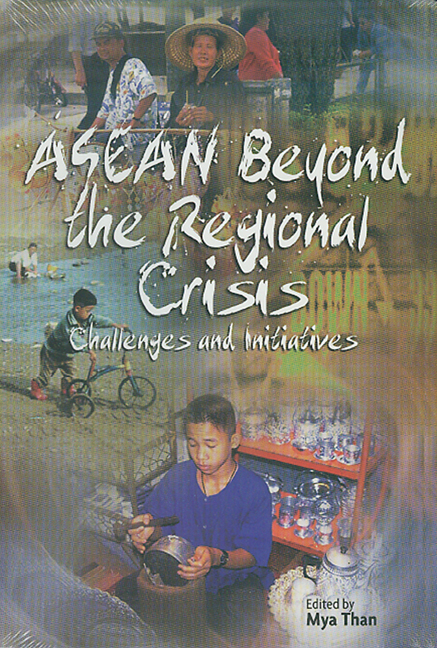Book contents
- Frontmatter
- Contents
- List of Tables
- List of Figures
- Glossary
- Contributors
- 1 ASEAN Beyond the Crisis: A Bird's-eye View
- 2 East Asia: Crisis and Recovery
- 3 Competitiveness and Sustainable Growth in ASEAN
- 4 ASEAN Free Trade Area: Progress and Challenges
- 5 ASEAN Investment Area: Progress and Challenges
- 6 Financial and Macroeconomic Co-operation in ASEAN: Issues and Policy Initiatives
- 7 Food Security in ASEAN
- 8 ASEAN Co-operation and the Environment
- 9 ASEAN and the International Trading System: Regional Trade Arrangement vs. the WTO
- 10 ASEAN and Its Inter-Regional Economic Links
- Appendix I ASEAN's Relevance: Has It Become Questionable?
- Appendix II Is ASEAN Still Relevant? Some Thoughts from a European Perspective
- Index
3 - Competitiveness and Sustainable Growth in ASEAN
Published online by Cambridge University Press: 03 November 2017
- Frontmatter
- Contents
- List of Tables
- List of Figures
- Glossary
- Contributors
- 1 ASEAN Beyond the Crisis: A Bird's-eye View
- 2 East Asia: Crisis and Recovery
- 3 Competitiveness and Sustainable Growth in ASEAN
- 4 ASEAN Free Trade Area: Progress and Challenges
- 5 ASEAN Investment Area: Progress and Challenges
- 6 Financial and Macroeconomic Co-operation in ASEAN: Issues and Policy Initiatives
- 7 Food Security in ASEAN
- 8 ASEAN Co-operation and the Environment
- 9 ASEAN and the International Trading System: Regional Trade Arrangement vs. the WTO
- 10 ASEAN and Its Inter-Regional Economic Links
- Appendix I ASEAN's Relevance: Has It Become Questionable?
- Appendix II Is ASEAN Still Relevant? Some Thoughts from a European Perspective
- Index
Summary
Overview
More than a year after the outbreak of the Asian financial crisis, there still does not seem to be a consensus on the proximate causes and hence what measures ought to be taken to avert its recurrence. Despite the numerous papers (scholarly as well as popular), conferences, publications, and official meetings that have proliferated since the start of the crisis, there is no convergence on its explanation — its unpredicted occurrence, its severity, and its wide spread across Asia and the rest of the world. At one extreme is a school of thought that the crisis was caused by fundamental weaknesses in the economies of the affected countries, manifested by macroeconomic imbalances, excessive borrowings, overvalued currencies, and poor investments, among other things (Moreno, et al. 1998; Glick 1998). At the other extreme is an argument that the crisis was triggered by speculators and their panic behaviour by withdrawing from the emerging markets in fear of losses (Moreno et al. 1998; Montes 1998). Between these two extremes are various shades of explanation. There is the notion of a lack of governance in both public and private transactions, especially in terms of close relationships between financial institutions and regulators. There is the notion that corruption weakened the system of investment decision-making in the emerging markets. There is the notion that “Asian values” had dictated the manner of financial exchanges. There is the notion that the crisis was essentially a bubble crisis (Nomura 1999). While the truth may lie somewhere between these two extremes, they have different policy implications. If the crisis was caused by fundamental weaknesses in the economy, the crisis-hit countries should carry out reforms to improve the foundation for sustainable development. On the other hand, if the crisis was caused by the sudden loss of confidence among short-term investors and speculators not directly related to country fundamentals, then the essential task is not really reforms, nor would they be necessary. Restoring confidence where the basic fundamentals are “correct” may require other measures that would bring back investors. Without a clear explanation for the crisis in the affected countries, it would be difficult to prescribe policy options.
- Type
- Chapter
- Information
- ASEAN Beyond the Regional CrisisChallenges and Initiatives, pp. 29 - 47Publisher: ISEAS–Yusof Ishak InstitutePrint publication year: 2001



